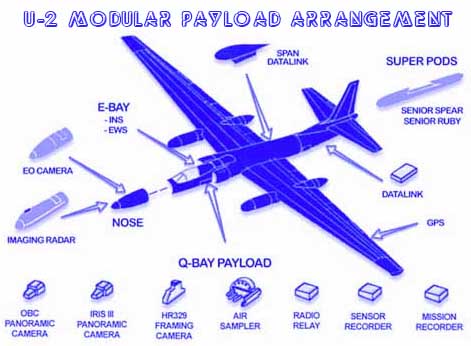
"Dragon Lady" also known as the Lockheed U-2, was built and designed in complete secrecy at Lockheed's "Skunk Works" by a team directed by Clarence L. "Kelly" Johnson in Burbank, Calif. This aircraft which is operated by the United States Air Force (USAF) and previously flown by the Central Intelligence Agency (CIA) is a single-engine, high-altitude reconnaissance aircraft. Dragon Lady provides all-weather intelligence gathering during the day and night at a very high-altitude. Other than that, it has also been used for electronic sensor research, satellite calibration, and communications purposes.
Armament: None
Engines: General Electric F118-GE-101 turbofan engine
Maximum speed: 500 mph
Range: 6,405 miles
Service ceiling: Plus 70,000 ft.
Span: 103 ft.
Length: 63 ft.
Height: 16 ft.
Weight: 40,000 lbs. loaded
Crew: One
During the Cold War, the U-2 Dragon Lady has prominently featured in several events, at stages of which U-2's frequently overflew the Soviet Union, North Vietnam, the People's Republic of China, and Cuba. It has remained in service since the end of the Cold War. The U-2 Dragon Lady is also one of several aircraft types that the USAF operated in excess of 50 years. It has took part in conflicts such as Afghanistan and Iraq, and supported various multinational NATO operations. The alternative platforms increasingly performed the role of the U-2, such as surveillance satellites, unmanned reconnaissance drones such as the Northrop Grumman RQ-4 Global Hawk, and conventional aircraft.
In a non-military role, the Lockheed U-2 has seen servicing with NASA as the ER-2 research aircraft. Despite its advanced age, due to its ability to perform direct flights to reconnaissance targets on short notice, the Lockheed U-2 Dragon Lady remains in service. This aircraft avoided the fate of retiring - some efforts for to retire existed in 2006 - due to the lack of an aircraft with similar capabilities. The USAF announced in 2009, that it intended to retain the U-2 through 2014 while working to develop the unmanned RQ-4 Global Hawk as a replacement. The aircraft on display is the last U-2A built.

No comments:
Post a Comment